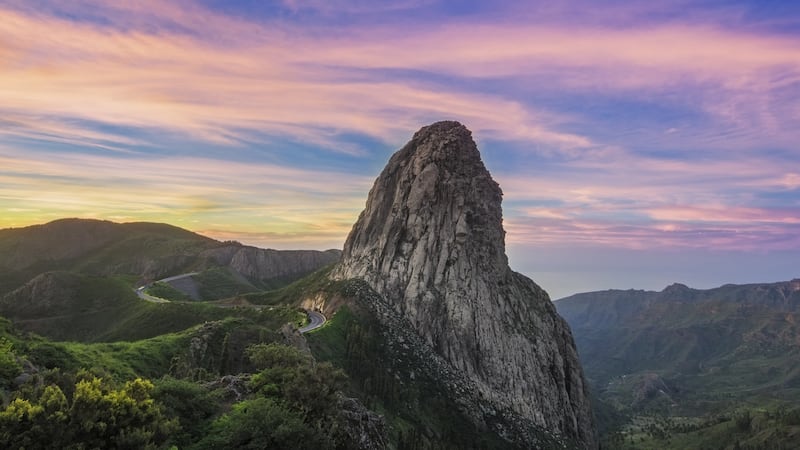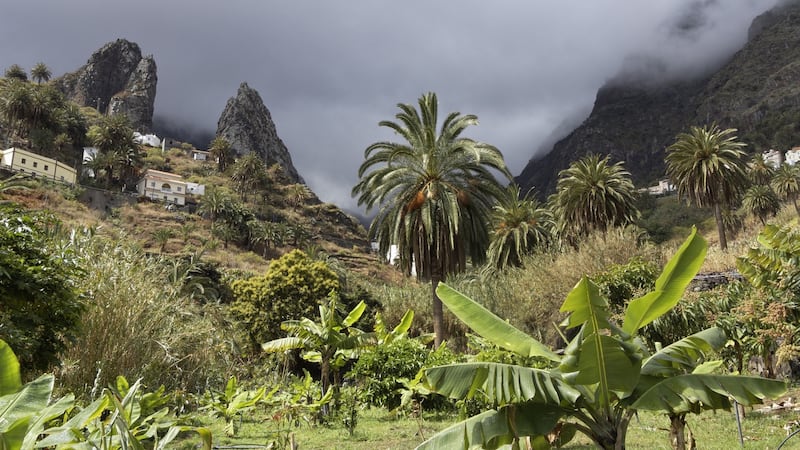With the heavy iron key that looked like a prop from a Harry Potter film, Pedro opened the old wooden door and I peered down into the well. As my eyes adjusted to the darkness of the room, I could see the gentlest of vibrations on the surface of the water. Just as Wolfgang had said, it was the ancient beating volcanic heart of La Gomera. I thanked him and went back into the bar to rejoin my friends and my beer.
Whether or not the legend was true, there is no doubt that if you're coming to the Canary Islands and looking for an authentic link to the islands' ancient past, you'll find it all around you on this most effervescently green isle.
Located just 20km or so to the west of Tenerife, La Gomera is easily accessed by a regular ferry link from Los Cristianos. Depending on whether you get the hydrofoil or the standard version, it will take either 40 minutes or an hour and a half.
0 of 3
La Gomera looks a bit like the upturned half of a huge green orange that has been broken into rough segments. A permanent rainforest of sorts resides across much of the upper reaches of the island, which are almost permanently shrouded in mist. It’s unlike any other of the Canaries that people are used to seeing, with their characteristic lunar landscapes and bare volcanic fields.

Here in La Gomera, all is lush – from the vast forests of banana trees that run to the shoreline at Santa Catalina to Europe's largest primitive forest, in the Unesco-listed Parque Nacional de Garajonay. Along the roadsides, exotic papaya fruits heave alongside banana trees. It looks as if the island could keep the entire population of Spain in fruit for the rest of their lives.
We were fortunate to run into Wolfgang and his French Moroccan-born wife Danielle near the start of our stay on La Gomera. With three friends, we had rented a house close to the village of Hermigua on the northeast of the island, just a 15-minute drive along the spectacular, twisty and perfectly-tarred road from the main town of San Sebastián.
Roomy terrace
The central meeting point in Hermigua is Pedro’s bar, with its views over the valley from the roomy terrace outside. Every night there was a themed music night. The first was a French night, where accordion-playing singers brought many of the French-speaking tourists and everyone else out to enjoy a folk-like, convivial atmosphere that turned the place into a little piece of Montmartre.
The second night was a Cuban night where we were treated to live music from a smashing band that wouldn't have been out of place on a pavement in Havana. The infectious music got everyone up and dancing around the terrace in the warm evening air.
The climate in La Gomera is a little bit different to most other Canary Islands too. The Canaries are known for the variation in temperature between the balmy middle of the day and the cooler evenings but, on La Gomera, you can experience cool spring weather requiring layers and rain gear up in the mountains while, by the seashore, high summer reigns supreme, with temperatures in the mid-20s and seawater warm enough to comfortably bathe in.
The next morning, I travelled north, near the beautifully formed and perfectly located village of Agulo, to a lookout area known as the Mirador de Abrante. Here, the car park ends in stunning red rock cliffs and a restaurant. Inside, the restaurant has a narrow glass floor extension to give you a dizzying perspective of the extraordinary views over the sea and colourful Agulo below.
The restaurant is also well known for the fact that some of its staff communicate through the fascinating whistling language El Silbo. Waiter Fabio was only too happy to give us a demonstration on site, asking us to tell him something in English or Spanish and then translating it into El Silbo. The language was brought to the Canaries by the Guanche people and has survived Spanish colonialism; it is now a mandatory subject for all Gomerans in both primary and secondary schools.
Quiet paradise
Wolfgang and Danielle had bought a house nearby and habitually spend most of the spring living in this green and relatively quiet paradise. After a first day of hard walking along the steep slopes of Hermigua and El Cedro, it was they who advised us to try the more user-friendly trail (10km return trip) from Pastrana to Benchijigua on the south side of the island.

We parked the hired car at the tiny village of Pastrana before heading north along the Barranco (ravine) de Benchijugua – a deep, rocky indentation where the waters flow at a variety of volumes depending on the weather. We started off at around 11am, and the weather was warm and sunny. The spectacular views towards the sea and up into the mountains were superb and the trail was well signposted and provided decent challenges for the average walker.
Along the way, we passed a number of isolated, deserted villages and hamlets before arriving at Benchijigua. It was a very quiet walk as well, and we only encountered a handful of walkers on the way. Benchijigua didn’t have anything by way of refreshing pitstop – just a few unoccupied holiday homes and a closed church – but it was a truly gorgeous spot with panoramic views in all directions from its elevated position looking down on a series of ravines and across to craggy hillsides on three sides.
The atmosphere is low-key, with a complete absence of the lager-lout brigade or the post-Leaving Cert party platoon
At this point, the weather was positively autumnal and even in three layers and with our hoods up, we had to keep moving to stay warm. By the time we got back to Pastrana, the afternoon sun was beating down on us once more. It being a Monday, the one restaurant in the hamlet was closed so we got in the car and drove down into the resort town of Playa de Santiago.
There are plenty of hotels and accommodation centres here to cater for all kinds of visitors, but the atmosphere is decidedly more low-key than most resorts you’ll find in the Canaries, with a complete absence of the lager-lout brigade or the post-Leaving Cert party platoon. Sun and sand it has a-plenty.
Comprehensive package
Valle Gran Rey offers a more comprehensive package for sun-worshippers looking for that little bit less Canary-like Canary Island sun resort, while the fine beaches at San Sebastián have the advantage of being next to the island's largest town. This is where Christopher Columbus stopped over before his historic voyage to the New World, and much of the town has managed to retain an old-world atmosphere. It's a place to wander around and take in the Spanish colonial vibes of its colourful, authentic streets.

Back at Hermigua, we were invited to spend an evening at Wolfgang and Christine’s lovely home – a chilled-out abode with a lot of traditional touches built on two levels. Upstairs, the tiled roof terrace covered the entire footprint of the building and was designed to cater for the outdoor life, complete with kitchen corner, large stone table and outdoor loo – all with superb views of lush mountains and blue sea and backing onto a tropical garden.
As the sun went down behind the mist-shrouded mountains, Wolfgang enquired if I had been able to witness the “beating heart of La Gomera” – if I’d seen for myself the pulse from the long-dormant volcanoes that formed the Canaries in the ripples on the surface of the water of the well at Pedro’s.
“Yes,” I said, uncertainly. “I think I did.”
He winked and raised his glass. “Then the beating heart of La Gomera will stay in your soul forever.”
Conor Power travelled with the support of the Spanish Tourism Office (spain.info) and La Gomera Tourist Board (lagomera.travel). See also the official Canary Islands tourism website (hellocanaryislands.com).














